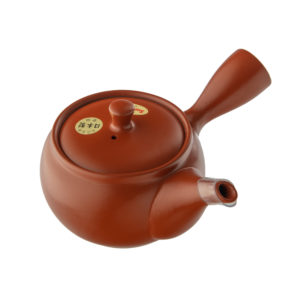It’s common for people to have a dedicated teapot for a type of tea, such as green tea.
I believe that this notion is more prevalent in Chinese tea culture.
Some people even use a teapot just for a specific tea.
Porous versus non-porous teapots
Clay teapots like the Tokonameyaki kyusu are porous, unless they are glazed.
This means that they can absorb liquids such as tea.
On one hand this is convenient because over time, a kyusu teapot will absorb the flavor of green tea, for example, and it will taste better.
But on the other hand, if you also prepare other types of tea in the same teapot it might affect the taste.
This is especially true if you are going to prepare flavored teas or tisanes.
I don’t recommend using those on porous teapots because their taste can be stronger or very different from straight tea.
For non-porous materials such as porcelain and glass, we don’t have to worry because they won’t absorb liquids.
Do you have more than one kyusu?
Since I only prepare Japanese teas in my kyusu teapots, and most of them are green teas, I don’t have much problems with mixing flavors.
But I must admit that I have prepared Japanese black teas in there as well.
While I have more than one kyusu, I have to use them all at the tea tastings that I do for many people. Hence, I can’t be picky in that respect.
I do have a small clay shiboridashi and a porcelain houhin that I keep just for gyokuro, kabusecha, and high grade sencha.
For other types of teas I use a gaiwan and a yixing teapot. Every now and then I enjoy a dark tea or an oolong.
I think that it is a matter of taste.
You can go as far as you want to, although personally I think that you can do most of the work with two or three teapots.
If you have the budget and space for a dedicated teapot for each type of tea, feel free to do so.






August 19, 2021
Ricardo, I think it’s absolutely okay to prepare different types of teas in the same Kyusu. Being a tea lover, I normally experiment with several samplers in the same teapot. They don’t hint at the taste at all. The only thing I make sure of is washing the pot with warm water immediately after use. This removes any scent or smell. However, do you still believe one should have separate teapots?
August 19, 2021
Hi Nisha
Maybe I didn’t express it correctly in the post, but the effect isn’t immediate. It’s over the long term as the the porous teapot ages.
One reason people buy the clay teapot is because after aging tea starts to taste better. But using different types of tea may interfere with the proper aging.
Again, this is done mostly with Chinese clay teapots. But it also applies to the kyusu.
August 20, 2021
Hi Ricardo, thank you for clarifying the fact. I will start noticing the change and definitely keep 2 more pots handy for parties. After all, no one wants their guests to have a weird taste.
August 20, 2021
If your clay teapot had some years of use, you can tell by comparing the tea made there with another teapot. It would be best if you had a new teapot of the same type to tell the exact difference.
August 20, 2021
You bet! I am doing it as the first thing now 🙂
September 12, 2022
Hi, I am a rookie who is about to start explorations in Tea-leaf-country.
Would it be okay then to brew all blends of green tea in my newly acquired non-glazed pot? Or should I better not brew certain variants of green tea in my ‘dedicated green teapot’? And if so, why is that?
September 12, 2022
Hi Maurits
By blend do you men that it is flavored tea? If so, I would definitely keep them of a porous teapot that I value.
I mix different teas (from the tea plant only) in some of my teapots, so it’s a matter of preference. But I wouldn’t prepare some other infusion (herbal teas, etc) there because some of those flavors can be too strong.
In your teapot dedicated to green tea, you can brew every green tea that you want.